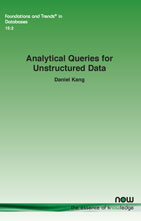Analytical Queries for Unstructured Data
By Daniel Kang, University of Illinois Urbana-Champaign, USA, ddkang@illinois.edu
Abstract
Unstructured data, in the form of text, images, video, and audio, is produced at exponentially higher rates. In tandem, machine learning (ML) methods have become increasingly powerful at analyzing unstructured data. Modern ML methods can now detect objects in images, understand actions in videos, and even classify complex legal texts based on legal intent. Combined, these trends make it increasingly feasible for analysts and researchers to automatically understand the “real world.” However, there are major challenges in deploying these techniques: 1) executing queries efficiently given the expense of ML methods, 2) expressing queries over bespoke forms of data, and 3) handling errors in ML methods.
In this monograph, we discuss challenges and advances in data management systems for unstructured data using ML, with a particular focus on video analytics. Using ML to answer queries introduces new challenges. First, even turning user intent into queries can be challenging: it is not obvious how to express a query of the form “select instances of cars turning left.” Second, ML models can be orders of magnitude more expensive compared processing traditional structured data. Third, ML models and the methods to accelerate analytics with ML models can be error-prone.
Recent work in the data management community has aimed to address all of these challenges. Users can now express queries via user-defined functions, opaquely through standard structured schemas, and even by providing examples. Given a query, recent work focuses on optimizing queries by approximating expensive “gold” methods with varying levels of guarantees. Finally, to handle errors in ML models, recent work has focused on applying outlier and drift detection to data analytics with ML.
Analytical Queries for Unstructured Data
Unstructured data, in the form of text, images, video, and audio, is produced at exponentially higher rates. In tandem, machine learning (ML) methods have become increasingly powerful at analyzing unstructured data. Modern ML methods can now detect objects in images, understand actions in videos, and even classify complex legal texts based on legal intent. Combined, these trends make it increasingly feasible for analysts and researchers to automatically understand the “real world.” However, there are major challenges in deploying these techniques: 1) executing queries efficiently given the expense of ML methods, 2) expressing queries over bespoke forms of data, and 3) handling errors in ML methods.
In this monograph, challenges and advances in data management systems for unstructured data using ML are discussed, with a particular focus on video analytics. Using ML to answer queries introduces new challenges. First, even turning user intent into queries can be challenging: it is not obvious how to express a query of the form “select instances of cars turning left.” Second, ML models can be orders of magnitude more expensive compared processing traditional structured data. Third, ML models and the methods to accelerate analytics with ML models can be error-prone.
Recent work in the data management community has aimed to address all of these challenges. Users can now express queries via user-defined functions, opaquely through standard structured schemas, and even by providing examples. Given a query, recent work focuses on optimizing queries by approximating expensive “gold” methods with varying levels of guarantees. Finally, to handle errors in ML models, recent work has focused on applying outlier and drift detection to data analytics with ML.
